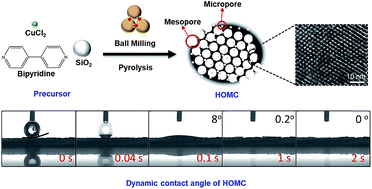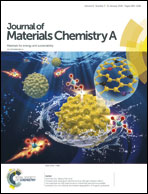Nanocasting in ball mills – combining ultra-hydrophilicity and ordered mesoporosity in carbon materials†
Abstract
A novel carbon material with an ultra-hydrophilic surface and an ordered arrangement of uniformly sized mesopores is synthesized via a solvent-free nanocasting approach conducted in a planetary ball mill. The synthesis involves a mechanochemical coordination reaction of bipyridine and copper chloride and its subsequent carbonization. Stemming from the synergistic effect of uniformly dispersed 34 wt% of heteroatoms and the highly ordered mesoporous structure (specific surface area >1000 m2 g−1, pore volume >1.2 cm3 g−1), the apparent water contact angle of the material is 0° – an unprecedented value for carbon materials. This novel type of carbon, with its tailorable pore structure, constitutes an ideal model material for fundamental investigations and can open new perspectives for advanced applications of porous carbons where polar wettability is crucial. Moreover, the solvent-free ball milling synthesis concept paves the way towards many novel materials, that syntheses are currently suffering from solubility issues in the nanocasting process.



 Please wait while we load your content...
Please wait while we load your content...